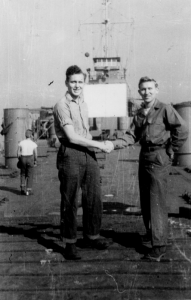This story has been told many times since 1945. It is true as told and verified by existing letters relating the event to the folks back home. It is a very favorite story from Japan.

Wilmer Larsen and I were best friends from first grade and on. We were even baptized at the same ceremony. We decided in the spring of 1944 to join the Navy in hopes that we would serve together. What happened instead was that we were called in immediately after our eighteenth birthdays and since I was three weeks older, I was called three weeks earlier than Wil.
We corresponded regularly and kept track of one another. By the fall of 1945 I knew that Wil was serving on an LST (Landing Ship Tank) and I knew the number of the ship. He knew that I was serving on the Harbor Entrance Control Post at the entrance to Tokyo Bay.
Therefore, it was not particularly surprising when, one day, the signalman on watch called through the speaking tubes which connected the tower with our rooms, saying something like, “hey Ras, there’s a convoy of LST’s coming in and the lead one is asking for you.” I figured it was Wil and a quick look at the numbers on the bow of the vessel confirmed that it was the ship he was serving on. I got on the light and identified myself to the signalman who said that Wil was standing beside him. We “talked” for a few minutes and made some general plans about visiting later on. Then we signed off with some casual comment like “see you soon.” Little did we know.
With nothing else to do at the time, I convinced our cox’n to take our landing barge out and follow the convoy. Perhaps I thought that we might find out where they were going to anchor. We were not making any real headway in getting closer when I spotted two flags go up on the flag hoist. I said something to the cox’n about getting lucky. The top flag signaled “speed” and the second one “zero.” It was an order for the convoy to stop. We pulled up to the fantail of the ship in question. It was not very high, perhaps twenty feet.
I called up to a sailor and asked him to get Wil Larsen. He did. Wil leaned over the rail and yelled “hi, Gerry,” and I responded “hi, Wil.”
At that point, the Cox’n informed me that the signalman on the bridge of the ship was trying to get my attention by using semaphore. I turned to the bridge and, using only my arms since I had no semaphore sticks, waggled “go ahead.”
He signaled “what is your message?”
I responded “no message.”
Wil takes the story from there. The signalman reported to the officer of the deck, “no message, sir.” The officer of the deck reported to the captain, “no message, sir.”
The captain said, “Well, I’ll be god-damned. A social call. Full speed ahead.” We had a pretty bumpy ride when the ship’s propellers started up.
But the story does not even end there. I got liberty the very next day and caught the train into Yokohama where, according to Port Director, the ships were anchored. I hitch hiked on a water taxi out to the anchorage. There I boarded the ship with careful attention to Navy ritual. First, salute the flag. Second, salute the officer of the deck and request permission to come aboard. He returned my salute and then, with a questioning look at my uniform, asked me who I worked for. Now since we had been assigned to amphibious forces we were wearing khaki and army like clothing, except for our white navy caps. I decided instantly not to mention HECP and said, truthfully enough, “Port Director.”
“Well, tell Port Director that some damn fool stopped this whole convoy out at the Harbor Entrance Control Post just to say hello to an old friend.”
I quickly responded “I will, sir,” and hastened on board. Wil and I had a nice reunion and later on he visited me at Toriga Saki. We also had a liberty or two together.
There is also a post script to this story. It was the only day in my entire Navy career where I used all three visual signaling skills in one day: Morse code via a blinker light, flag hoist and semaphore.


Pingback: Remembering Japan: 1945-1946: Chapter Nine: A Social Call | I Make Up Worlds
Pingback: Remembering Japan: 1945 – 1946: Chapter Ten: Japanese Hot Tub | I Make Up Worlds
Pingback: Remembering Japan 1945 – 1946: Chapter Eleven: Madame Butterfly | I Make Up Worlds
Pingback: Remembering Japan: 1945 – 1946: Chapter Twelve: The “Singers” | I Make Up Worlds